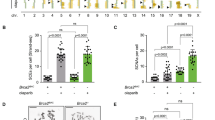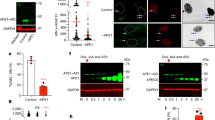Summary
A model of the sister chromatid exchange (SCE) process is outlined as a replication mechanism to bypass DNA crosslinks. The model suggests that when normal bidirectional replication advances from both sides towards a crosslink along the two opposite parental strands, the complementary parental strand segments can be temporarily displaced at each contralateral 5′ side from the crosslink. The free ends produced in this first step will be terminally aligned but will have opposite polarity. The second step of the bypass can, however, be completed by either of two rejoining processes—terminal ligation of the free ends via nascent Okazaki pieces or aberrant complementation by overlapping the free ends. This bypass mechanism (1) allows replication to continue past a crosslink leaving it intact but (2) results in the switching of parental strands and their attached incomplete nascent strands above and below the crosslink site producing an exchange between sister chromatids. This model is compatible with the findings of current SCE studies using the new BUDR/stain techniques as well as with previous autoradiographic studies. It also suggests that the chromatid breaks and deletions in Fanconi's Anemia represent a defect in step two of the replication bypass mechanism and that the high frequency of SCE's and quadriradials in Bloom's Syndrome represent the SCE overload effects of a defect in crosslink repair.
Similar content being viewed by others
References
Allen, J. W., Latt, S. A.: Analysis of sister chromatid exchange formation in vivo in mouse spermatogonia as a new test system for environmental mutagens. Nature 260, 449–451 (1976)
Angell, R. R., Jacobs, P. A.: Lateral asymmetry in human constitutive heterochromatin. Chromosoma (Berl.) 51, 301–310 (1975)
Bender, M. A., Griggs, H. G., Bedford, J. S.: Recombinational DNA repair and sister chromatid exchanges. Mutat. Res. 24, 117–123 (1974)
Chaganti, R. S. K., Schonberg, S., German, J.: A manyfold increase in sister chromatid exchanges in Bloom's Syndrome lymphocytes. Proc. Nat. Acad. Sci. USA 71, 4508–4512 (1974)
Cleaver, J. E., Thomas, G. H.: Single strand interruptions in DNA and the effects of caffeine in Chinese Hamster cells irradiated with ultraviolet light. Biochem. biophys. Res. Commun. 36, 203–208 (1969)
Cole, R. S.: Repair of DNA containing interstrand crosslinks in Escherichia coli: Sequential excision and recombination. Proc. Nat. Acad. Sci. USA 70, 1064–1068 (1973)
Cole, R. S.: Psoralen crosslinks in DNA: Formation consequences and repair. In: Progress in photobiology, G. O. Schenck, ed., p. 019a-021. Frankfurt: Deutsche Gesellschaft für Lichtforschung 1974
Cole, R. S., Levitan, D., Sinden, R. R.: Removal of psoralen interstrand cross-links from DNA of escherichia coli: Mechanism and genetic control. J. Mol. Biol. 102, 000–021 (in press), 1977)
Comings, D. E.: Implications of somatic recombination and sister chromatid exchange in Bloom's Syndrome and cells treated with mitomycin C. Humangenetik 28, 191–196 (1975)
Dutrillaux, B., Fosse, A. M., Prieur, M., Lejeune, J.: Chromatid exchanges in human mitotic cells. BUdR treatment and biochromatic fluorescence by acridine orange. Chromosoma (Berl.) 48, 327–340 (1974)
Gatti, M., Pimpinelli, S., Ollivieri, G.: The frequency and distribution of isolabeling in Chinese Hamster chromosomes after exposure to X-rays. Mutat. Res. 23, 229–238 (1974)
German, J., LaRock, J.: Chromosomal effects of mitomycin, a potential recombinogen in mammalian cell genetics. Tex. Rep. Biol. Med. 27, 409–418 (1969)
German, J., Archibald, R., Bloom, D.: Chromosomal breakage in a rare and probably genetically determined syndrome of man. Science 148, 506–507 (1965)
German, J., Crippa, L. P., Bloom, D.: Bloom's Syndrome III: Analysis of the chromosome aberration characteristic of this disorder. Chromosoma (Berl.) 48, 361–366 (1974)
Holliday, R.: A mechanism for gene conversion in fungi. Genet. Res. 5, 282–304 (1964)
Howard-Flanders, P.: DNA repair and recombination. Br. Med. Bull. 29, 226–235 (1973)
Howard-Flanders, P., Cole, R. S., Ma, P. F.: Excision and recombination in the repair of DNA in bacteria treated with ultraviolet light or cross-linking agents. Studia Biophysica 36, 211–220 (1973)
Kato, H.: Induction of sister chromatid exchanges by UV light and its inhibition by caffeine. Exp. Cell Res. 82, 383–390 (1973)
Kato, H.: Induction of sister chromatid exchanges by chemical mutagens and its possible relevance to DNA repair. Exp. Cell Res. 85, 239–247 (1974a)
Kato, H.: Is isolabeling a false image? Exp. Cell Res. 89, 416–420 (1974b)
Kato, H.: Possible role of DNA synthesis in formation of sister chromatid exchanges. Nature 252, 739–741 (1974c)
Kato, H., Shimada, H.: Sister chromatid exchanges induced by mitomycin C: a new method of detecting DNA damage at chromosomal level. Mutat. Res. 28, 459–464 (1975)
Kato, H., Stich, H. F.: Sister chromatid exchanges in ageing and repair-deficient human fibroblasts. Nature 260, 447–448 (1976)
Kato, H.: Mechanisms for siter chromatid exchanges and their relation to the production of chromosome aberrations. Chromosoma (Berl.) 59, 179–191 (1977)
Kihlman, B. A.: Sister chromatid exchanges in Vicia faba. II. Effects of thiotepa, caffeine and 8-ethoxycaffeine on the frequency of SCE's. Chromosoma (Berl.) 51, 11–18 (1975)
Korenberg, J. R., Freedlender, E. F.: Giemsa technique for the detection of sister chromatid exchanges. Chromosoma (Berl.) 48, 355–360 (1974)
Latt, S. A.: Localization of sister chromatid exchanges in human chromosomes. Science 185, 74–76 (1974a)
Latt, S. A.: Sister chromatid exchanges, indices of human chromosome damage and repair: Detection by fluorescence and induction of mitomycin C. Proc. Nat. Acad. Sci. USA 71, 3162–3166 (1974)
Latt, S. A., Stetten, G., Juergens, L. A., Buchanan, G. R., Gerald, P. S.: Induction by alkylating agents of sister chromatid exchanges and chromatid breaks in Fanconi's anemia. Proc. Nat. Acad. Sci. USA 72, 4066–4070 (1975)
Lin, M. S., Davidson, R. L.: Centric fusion, satellite DNA, and DNA polarity in mouse chromosomes. Science 185, 1179–1181 (1974)
Meselson, M. S., Radding, C. M.: A general model for genetic recombination. Proc. Nat. Acad. Sci. USA 72, 358–361 (1975)
Parrish, J. A., Fitzpatrick, T., Tanenbaum, L., Pathak, M. A.: Photochemotherapy of psoriasis with oral methoxsalen and longwave ultraviolet light. N. Engl. J. Med. 291, 1207–1211 (1974)
Perry, P., Evans, H. J.: Cytological detection of mutagen-carcinogen exposure by sister chromatid exchange. Nature 258, 121–125 (1975)
Perry, P., Wolff, S.: New Giemsa method for differential staining of sister chromatids. Nature 251, 156–158 (1974)
Rommelaere, J., Miller-Faurès, A.: Detection by density equilibrium centrifugation of recombinant-like DNA molecules in somatic mammalian cells. J. Mol. Biol. 98, 195–218 (1975)
Sasaki, M. S., Tonomura, A.: A high susceptibility of Fanconi's anemia to chromosome breakage by DNA cross-linking agents. Cancer Res. 33, 1829–1836 (1973)
Schroeder, T. M.: Sister chromatid exchange- and chromatid interchanges in Blooms' syndrome. Humangenetik 30, 317–323 (1975)
Sehgal, V. N.: A comparative clinical evaluation of trimethylpsoralen, psoralen and 8-methoxypsoralen in treating vitiligo. Int. J. Dermatol. 14, 205–208 (1975)
Shafer, D. A., Tadayon, F., Hollingsworth, F., Falek, A.: Giemsa staining of DNA replication patterns and simultaneous localization of sister chromatid exchanges. Am. J. Hum. Genet. 27, 80A (1975)
Shafer, D. A., Hollingsworth, F., Tadayon, F., Falek, A.: Giemsa replication (GR) banding of metaphase chromosomes. Mam. Chrom. Newsltr. 17, 62 (1976)
Shafer, D. A., Tadayon, F. B., Falek, A.: Sister chromatid exchange induction with psoralen plus blacklight. Mam. Chrom. Newsltr. 18, 49 (1977)
Smyth, D. R., Evans, H. J.: Mapping of sister-chromatid exchanges in human chromosomes using G-banding and autoradiography. Mutat. Res. 35, 139–154 (1976)
Strauss, B. S.: Nuclear DNA. In: The cell nucleus, H. Busch, ed., Vol. III, pp. 3–33. New York: Academic Press 1974
Taylor, J. H.: Sister chromatid exchanges in tritium-labeled chromosomes. Genetics 43, 515–529 (1958)
Tice, R., Chailet, J., Schneider, E. L.: Evidence derived from sister chromatid exchanges of restricted rejoining of chromatid subunits. Nature 256, 642–644 (1975)
Vogel, W., Bauknecht, T.: Differential chromatid staining by in vivo treatment as a mutagenicity test system. Nature 260, 448–449 (1976)
Walter, J. F., Voorhees, J. J.: Psoriasis improved by psoralen plus blacklight. Acta Derm. Venereol. 53, 469–472 (1973)
Whitehouse, H. L. K.: A theory of crossing-over by means of hybrid deoxyribonucleic acid. Nature (Lond.) 199, 1034–1040 (1963)
Wolff, S., Perry, P.: Insights on chromosome structure from sister chromatid exchange ratios and the lack of both isolabeling and heterolabeling as determined by the FPG technique. Exp. Cell Res. 93, 23–30 (1975)
Wolff, S., Perry, P.: Differential Giemsa staining of sister chromatids and the study of sister chromatid exchanges without autoradiography. Chromosoma (Berl.) 48, 341–353 (1974)
Wolff, S., Bodycote, J., Painter, R. B.: Sister chromatid exchanges induced in Chinese hamster cells by UV irradiation of different stages of the cell cycle: The necessity for cells to pass through S. Mutat. Res. 25, 73–81 (1974)
Wolff, S., Bodycote, J., Thomas, G. H., Cleaver, J. E.: Sister chromatid exchange in Xeroderma Pigmentosum cells that are defective in DNA excision repair or post-replication repair. Genetics 81, 349–355 (1975)
Author information
Authors and Affiliations
Rights and permissions
About this article
Cite this article
Shafer, D.A. Replication bypass model of sister chromatid exchanges and implications for Bloom's Syndrome and Fanconi's anemia. Hum Genet 39, 177–190 (1977). https://doi.org/10.1007/BF00287010
Received:
Accepted:
Issue Date:
DOI: https://doi.org/10.1007/BF00287010




